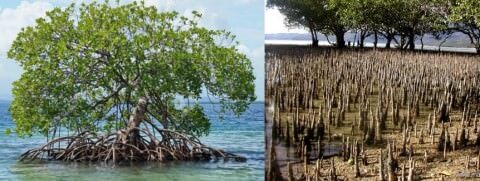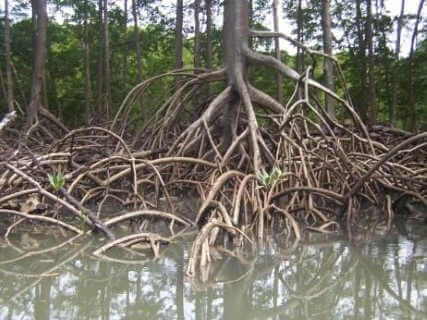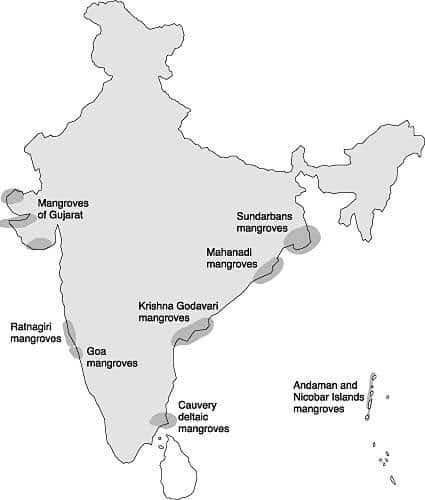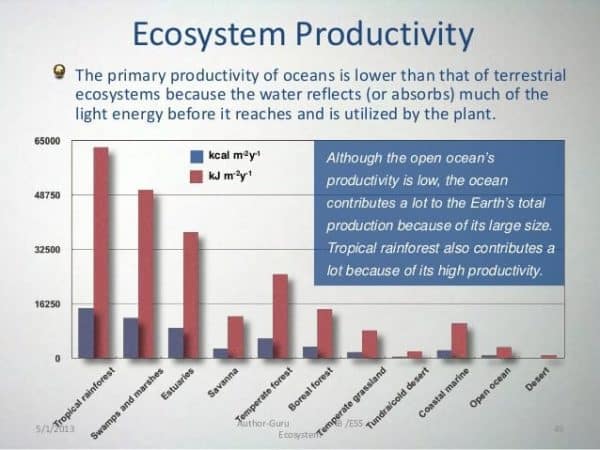Mangroves
- Mangroves are plants that grow in inter-tidal areas. They are halophytes (‘salt-loving”). Most plants can not survive in salty conditions.
- Mangroves live in a unique environment-between land and sea.
- Mangroves represent a characteristic littoral (near the seashore) forest ecosystem.
- These are mostly evergreen forests that grow in sheltered low-lying coasts, estuaries, mudflats, tidal creeks backwaters (coastal waters held back on land), marshes, and lagoons of tropical and subtropical regions.
- Mangroves grow below the high water level of spring tides.
- The best locations are where abundant silt is brought down by rivers or on the backshore of accreting sandy beaches.
- Mangroves are highly productive ecosystems, and the trees may vary in height from 8 to 20 m. They protect the shoreline from the effect of cyclones and tsunamis.
- They are breeding and spawning ground for many commercially important fishes.
- Since mangroves are located between the land and sea, they represent the best example of the ecotone.
- Mangroves are shrubs or small trees that grow in coastal saline or brackish water.
- Mangroves are salt-tolerant trees, also called halophytes, and are adapted to harsh coastal conditions.
- Mangrove vegetation facilitates more water loss. Leaves are thick and contain salt-secreting glands. Some block absorption of salt at their roots itself.
- They contain a complex salt filtration system and complex root system to cope with saltwater immersion and wave action.
- They are adapted to the low oxygen (anoxic) conditions of waterlogged mud.
- They produce pneumatophores (blind roots) to overcome the respiration problem in anaerobic soil conditions.
- Mangroves occur worldwide in the tropics and subtropics, mainly between latitudes 25° N and 25° S.
- They require high solar radiation to filter saline water through their roots. This explains why mangroves are confined to only tropical and subtropical coastal waters.
- Mangroves occur in a variety of configurations. Some species (e.g. Rhizophora) send arching prop roots down into the water.
- While others (e.g. Avicennia) send vertical “Pneumatophores” or air roots up from the mud.
- Adventitious roots that emerged from the main trunk of a tree above ground level are called stilt roots.


- Mangroves exhibit a Viviparity mode of reproduction. i.e. seeds germinate in the tree itself (before falling to the ground).
- Vivipary: The seed remains attached to the parents’ plant until it germinates. It then falls from the tree and drifts on the water until it finds somewhere to take root.
- This is an adaptive mechanism to overcome the problem of germination in saline water.
- There are three types of Mangroves:
- Red – Found along the coastlines
- Black – Major feature of such mangrove trees is their dark bark. They have access to more oxygen.
- White – Compared to Red and Black mangroves; they grow at the highest elevation.
Mangroves in India
- The major mangroves in India are found at:
- Sundarban Groves
- Mahanadi Mangroves
- Krishna Godavari Mangroves
- Mangroves of Gujarat
- Ratnagiri Mangroves
- Goa Mangroves
- Cauvery Deltaic Mangroves
- Andaman Nicobar Mangroves
- The mangroves of Sundarbans are the largest single block of tidal halophytic mangroves in the world.
- This mangrove forest is famous for the Royal Bengal Tiger and crocodiles.
- Mangrove areas here are being cleared for agricultural use.
- The mangroves of Bhitarkanika (Orissa), which is the second largest in the Indian sub-continent, harbour high concentration of typical mangrove species and high genetic diversity.
- Mangrove swamps occur in profusion in the intertidal mudflats on both sides of the creeks in the Godavari-Krishna deltaic regions of Andhra Pradesh.
- Mangroves of Pichavaram and Vedaranyam are degraded mainly due to the construction of aquaculture ponds and salt pans.
- On the west coast of India, mangroves, mostly scrubby and degraded occur along the intertidal region of estuaries and creeks in Maharashtra, Goa, and Karnataka.
- The mangrove vegetation in the coastal zone of Kerala is very sparse and thin.
- In Gujarat (north-west coast) mangroves Avicennia marine, Avicennia officinalis, and Rhizophora mucronata are found mainly in the Gulf of Kutch and the Kori creek.
- Mangroves are of scrubby type with stunted growth, forming narrow, discontinuous patches on soft clayey mud.
- The condition of the mangroves is improving especially in the Kori creek region, which is a paleodelta of the Indus river (once upon a time it was part of the Indus delta).
- In size, mangroves range from bushy stands of dwarf mangroves found in the Gulf of Kutch to taller stands found in the Sunderbans.
- On the Andaman & Nicobar Islands, the small tidal estuaries and the lagoons support a dense and diverse undisturbed mangrove flora.

Importance of Mangroves
- Mangrove plants have (additional) special roots such as prop roots, pneumatophores which help to impede water flow and thereby enhance the deposition of sediment in areas (where it is already occurring), stabilize the coastal shores, provide a breeding ground for fishes.
- Mangroves moderate monsoonal tidal floods and reduce the inundation of coastal lowlands.
- They prevent coastal soil erosion. Mangrove roots hold sediments back and prevent erosion.
- They protect coastal lands from tsunami, hurricanes, and floods. Mangroves protect human settlements from storm and typhoons. Coastal communities need the mangroves for natural protection.
- Mangroves enhance the natural recycling of nutrients.
- Mangrove supports numerous florae, avifauna, and wildlife.
- The leaf detritus also provides food for animals such as worms, snails,mussels, oysters,shrimp, clams and mullet.
- Provide a safe and favorable environment for breeding, spawning, rearing of several fishes.
- Fish, shellfish, crabs and other species need mangroves to survive.
- They supply woods, firewood, medicinal plants, and edible plants to local people.
- They provide numerous employment opportunities to local communities and augments their livelihood.
- Mangroves contribute to our economy;they have a big influence on our fisheries, because so many commercially fished species breed or develop there. The mangroves also provide an important source of food for other marine life.
Threats
They are destroyed for the conversion of the area for agricultural purposes, fuel, fodder and, salinization, mining, oil spills, aquacultural (shrimp farming), use of chemical pesticides & fertilizers, industrial purposes.
- From seas – Sea level rise, cyclones and tsunami, coastal erosion, oil spills
- From rivers – Polluted water
- From Communities– Destroyed for fuel, fodder
- Plastic bags and other waste is a major threat for mangroves.
- Goats can destroy mangrove seedlings and damage mature trees.
- Pests
Mangroves around the world
- It is estimated that the world has lost 20% of its mangrove forests since 1980.
- This could have alarming effects on biodiversity, due to loss of habitat.
- It could also result in the silting of coral reefs, shipping lanes and ports.
- Loss of mangroves could also severely impact economies that rely on tourism and fisheries.
- Without a barrier of mangroves low lying countries such as Bangladesh, are more susceptible to flooding and devastation by cyclones.
Present status of Mangroves
- Although mangroves are decreasing the rate is slowing down as more countries pass laws to protect them. More projects to replant mangroves are underway around the world, but there is still along way to go before this ecosystem is protected.

State Forest Report 2019
According to the Forest Survey of India, 2019, Mangroves’ cover in the country increased by 54 sq km (1.10 percent) in comparison to the 2017 assessment. The significant points put across by the State Forest Report 2019:
- Mangroves face limiting factors like:
- Lack of Oxygen
- High Salinity
- Diurnal Tidal Inundations
- Mangroves adapt the following to live with their limiting factors:
- Succulent Leaves
- Sunken Stomata
- Pneumatophores (Aerial Roots)
- Vivipary
- Stilt roots
- Buttresses
- Mangroves make 1 percent of the tropical forests of the world.
- India has 3 percent of the total mangrove cover in South Asia.
- There are some important mangrove species in India:
- Avicennia Officinalis
- Morinda Citrifolia
- Rhizophora mucronata
- Sonneratia Alba
- Avicennia Alba
- Bruguiera Cylindrica
- Heriteira Littoralis
- Phoenix paludosa
- Ceriops Tagal
- Mangrove Cover in India is 4975 sq km (0.15 percent of the total geographical area.)
- Mangrove cover is divided as:
- Very Dense – 1476 sq km (29.66 percent)
- Moderately Dense – 1479 sq km (29.73 percent)
- Open Mangroves – 2020 sq km (40.61 percent)
- West Bengal has 42.45 percent of India’s mangrove cover (highest in the country.)
List of Mangrove Sites in India
| Mangrove Sites | State/Union Territories |
|---|---|
| Sunderbans | West Bengal |
| Bhaitarkanika Mahanadi Subarnarekha Devi-Kauda Dhamra Mangrove Genetic Resources Centre Chilka | Orissa |
| Coringa East Godavari Krishna | Andhra Pradesh |
| North Andaman Nicobar | Andaman & Nicobar |
| Pichavaram Muthupet Ramnad Pulicat Kaznuveli | Tamil Nadu |
| Vembanad Kannur (North Kerala) | Kerala |
| Coondapur Dakshin Kannada/ Hannavar Karwar Mangalore Forest Division | Karnataka |
| Goa | Goa |
| Achra-Ratnagiri Dev Garh-Vijay Durg Veldur Kundalika-Revdnada Mumbra-Diva Vikroli Shreevardhan Vaitarna Vasai-Manori Malvan | Maharashtra |
| Gulf of Kutchh Gulf of Khambhat Dumas-Ubhrat | Gujarat |
Coringa Wildlife Sanctuary
- Coringa Wildlife Sanctuary is a wildlife sanctuary and estuary situated near Kakinada in Andhra Pradesh.
- Godavari Mangroves at the Coringa Wildlife Sanctuary (CWLS) is touted to be the second-largest mangroves in India with 24 mangrove tree species and more than 120 bird species. The largest mangrove forest in the world is Sundarbans, West Bengal.
- It is home to the critically endangered white-backed vulture and the long-billed vulture.
- The sanctuary also has a site where Olive Ridley Sea Turtles nest from January to March every year.


good work
GREAT
GOD BLESS TO THE BRILLIANT MINDS CURATING SUCH WONDERFUL CONTENT FOR ALL ASPIRANTS